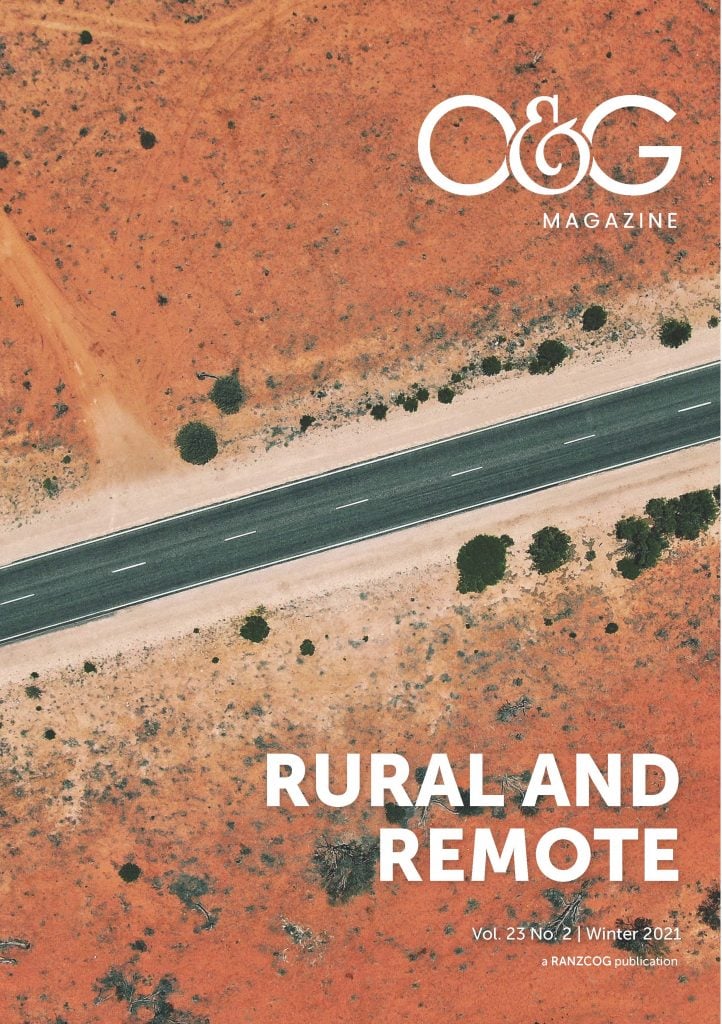Polly presents to our regional maternity service one evening with a history of vaginal clear fluid leaking for six hours. She has driven herself to the hospital from a farm located three hours away. It’s her third baby, she’s 28 weeks and it’s the middle of harvest. There’s no paediatrics or nursery in our town; we are rated to manage low-risk pregnancies beyond 37 weeks.
Our medical student has taken the history when I arrive. A 30-year-old G3P2 with two previous caesareans. Pregnancy normal so far, dates confirmed with early scan. Normal morphology, posterior placenta, cervical length at anatomy scan and low-risk antenatal investigations.
We do a sterile spec and confirm there is clear fluid and swabs are taken. The cervix looks soft, erythematous and floppy. It’s difficult to know if she is dilating. We don’t do a vaginal examination. With bedside ultrasound I discover that the baby is breech. I can’t see any cord presenting. The CTG has been on since she arrived baseline 145, good variability, no decelerations and no accelerations. She has started tightening 3:10. The midwife is already commencing the transfer paperwork. We give nifedipine, 20mg orally and I chart two more doses. Our medical student puts in an IV. I chart intramuscular betamethasone and oral erythromycin as I start making my phone calls. The midwife is nervous, ‘should I draw up the salbutamol?’ We know the tertiary centre is not keen on it, but the converse is that intrauterine transfer is preferable at 28 weeks. I advise her to have it ready, especially if we require aeromedical transfer.
I call the tertiary centre obstetrics registrar, ‘Yes, of course, send them up. Just give celestone, antibiotics, tocolysis.’ I mention salbutamol. ‘You need to give the nifedipine time to work.’ I think I’d prefer hypotension and tachycardia right now over a 28-week newborn.
I call the Royal Flying Doctor Service (RFDS). There is a familiar, reassuring script ‘RFDS operations, how can I help you?’
‘I have a patient with preterm ruptured membranes who needs to be transferred to Perth.’ Name and date of birth are duly given. Then I am derailed. They ask, ‘how much does she weigh?’ This question always surprises me. It’s in the script but seems out of place when we are so accustomed to an ISOBAR handover: introduction, observation, situation, background, assessment and recommendation. It reminds me of the different priorities that we have. I need to get this high-risk patient to a safer place as soon as possible. Royal Flying Doctor Service need to triage and coordinate their retrievals, calculate load, fuel and distance. A different world of problems to mine.
We find our tiny Neopuff TM masks and plastic wraps to keep a preterm baby warm if needed. I refamiliarise myself with the umbilical line kit. I’m filled with adrenaline and my heartrate of 130 matches the CTG.
The obstetrics registrar was right, the tightenings settle without salbutamol. Polly is a bit teary as the situation sinks in. I explain what is going on and I try to mentally prepare her for the days and weeks ahead. The baby is going to be born preterm. They’ll need intensive care, breathing support and IV lines for 10 weeks or so.
She has been on the phone. Their neighbours will help with the harvest. Her husband will set off to Perth now and meet her there. Her kids will stay on the farm with her in-laws. Her car can stay in the hospital car park for now. The standard-issue red Royal Flying Doctor Service bag is all she can take with her.
Royal Flying Doctor Service will be on the ground at 10.45pm. A midwife will escort her to the airport. After all the drama, I almost forget to write the transfer letter.
Two days later we hear that she had a non-elective lower uterine segment caesarean section of a 1.7kg baby boy. The baby is in the nursery and doing well. Ten weeks later, he is discharged. Polly comes to see me at the GP practice on her original due date. Baby Toby is doing well, he is now 3.2kg. The family were provided accommodation in Perth over Christmas. Everyone was kind, the service was amazing. They are grateful to have access to healthcare, despite the geographical distances.
Polly’s experience is not unique, with the Royal Flying Doctor Service between the years 2015–2017 conducting 2171 aeromedical retrievals for pregnancy-related diagnoses from remote Australia (Table 1).
Table 1. In-flight diagnosis of pregnancy-related aeromedical retrievals from rural and remote Australia (2015–2017).1
| Description | Number (%) |
| All pregnancy-related diagnoses | 2171 |
| Primary evacuations | 152 (7.0) |
| Secondary evacuations | 2019 (93.0) |
| Threatened preterm labour and delivery | 883 (40.7) |
| Antepartum haemorrhage | 172 (7.9) |
| Pre-eclampsia | 143 (6.6) |
| Ectopic pregnancy | 77 (3.5) |
| All others | 552 (25.4) |
Threatened preterm labour is defined as labour prior to 37 weeks and is the most common reason for the Royal Flying Doctor Service to retrieve pregnant women in Australia.1 A large proportion of women reside in rural and remote Australia, and while early transfer is preferable, these women can still experience sudden complications and require emergency transfer. Management depends upon the capacity of the maternity unit to manage the preterm neonate. Tocolysis is employed to delay labour to facilitate transfer. In almost all cases, intrauterine transfer is preferable to transferring a preterm neonate.
A major challenge facing rural and remote families is limited availability of O&G services. Between the years 1992–2011, there was a 41.0% reduction in the total number of maternity units in Australia from 623 to 368, with remote areas experiencing more rapid declines.2 This is consistent with the Royal Flying Doctor Service finding that the majority of women requiring aeromedical retrieval for pregnancy (n=1204; 55.5%) from a rural or remote area, did not have access to a local O&G service.3
The loss of local hospital-based obstetric care may be a key contributor to the increased maternal health challenges we are facing in remote Australia, with aeromedical retrievals for pregnancy growing from 3.1% (of all Royal Flying Doctor Service transfers) between 2015–18 to 3.5% in 2018–19 (p-value 0.01).4 Women and infants who require an aeromedical retrieval have higher rates of low-birth weight, preterm births and infant mortality, as compared to Australian rates.5 This is consistent with findings from America, which found that loss of hospital-based obstetric services was associated with increased out-of-hospital preterm births.6
Women like Polly are geographically, and often socially isolated. Pregnancy can be a stressful time for many women, regardless of remoteness. This includes worrying about the fetus, labour, delivery, and broader family and social responsibilities. Rural and remote areas have higher rates of socio-economic disadvantage, poverty with reduced access to services, lower educational attainment and poorer health. These disparities increase with remoteness.
The Royal Flying Doctor Service retrieved 658 Indigenous mothers from remote Australia, representing 30.3% of total pregnancy-related retrievals between the years 2015–2017. Many of these were for preterm labour,7 which is twice as common for Indigenous women.8
While retrieval does bring women to essential medical care, the psychological burden of relocation away from land and community is significant. Indigenous women, who represent 25%–45% of the remote population, can exhibit extreme levels of post-traumatic stress disorder symptoms during their pregnancy, with a major contributor being a fear of preterm birth.9
High rates of pregnancy complications such as preterm birth and increasing rates of retrieval reveal a gap in rural and remote pregnancy care. Stable, local and community-based O&G services are essential to provide services to the people in most need.
References
- Gardiner F, Richardson A, Roxburgh C, et al. Characteristics and in-hospital outcomes of patients requiring aeromedical retrieval for pregnancy, compared to non-retrieved metropolitan cohorts. ANZJOG. 2021;In press
- Kildea S, McGhie AC, Gao Y, et al. Babies born before arrival to hospital and maternity unit closures in Queensland and Australia. Women Birth. 2015;28(3):236-45.
- Gardiner F, Richardson A, Roxburgh C, et al. Characteristics and in-hospital outcomes of patients requiring aeromedical retrieval for pregnancy, compared to non-retrieved metropolitan cohorts. ANZJOG. 2021;In press
- Gonzalez-Chica D, Gillam M, Williams S, et al. Pregnancy-related aeromedical retrievals in rural and remote Australia: national evidence from the Royal Flying Doctor Service. BMC Health Services Research. 2021;In press
- Gardiner F, Richardson A, Roxburgh C, et al. Characteristics and in-hospital outcomes of patients requiring aeromedical retrieval for pregnancy, compared to non-retrieved metropolitan cohorts. ANZJOG. 2021;In press
- Kozhimannil KB, Hung P, Henning-Smith C, et al. Association Between Loss of Hospital-Based Obstetric Services and Birth Outcomes in Rural Counties in the United States. JAMA. 2018;319(12):1239-47.
- Gardiner F, Richardson A, Roxburgh C, et al. Characteristics and in-hospital outcomes of patients requiring aeromedical retrieval for pregnancy, compared to non-retrieved metropolitan cohorts. ANZJOG. 2021;In press
- Mah B, Weatherall L, Burrows J, et al. Post-traumatic stress disorder symptoms in pregnant Australian Indigenous women residing in rural and remote New South Wales: A cross-sectional descriptive study. ANZJOG 2017;57(5):520-25.
- Mah B, Weatherall L, Burrows J, et al. Post-traumatic stress disorder symptoms in pregnant Australian Indigenous women residing in rural and remote New South Wales: A cross-sectional descriptive study. ANZJOG 2017;57(5):520-25.







Leave a Reply